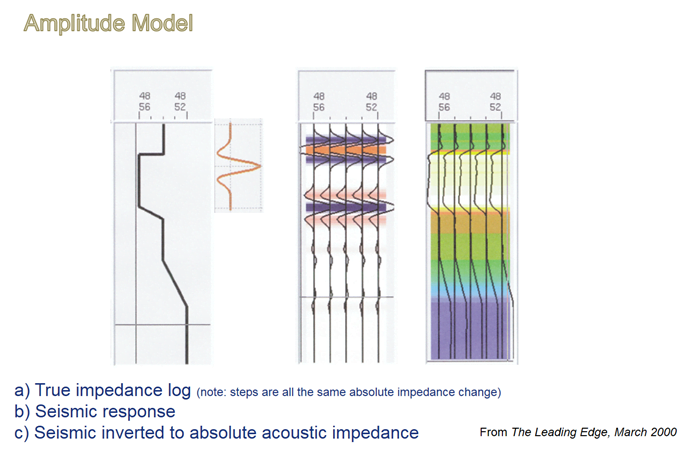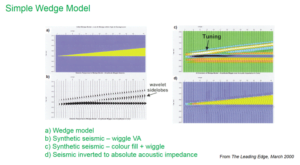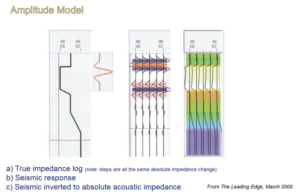The aim of Seismic Inversion is to transform the conventional seismic reflection signals into layered properties that distinguish different formations.
When seismic reflection signals to be inverted are conventional stack traces – ideally near offset responses – the formation property of the layered model to be estimated is acoustic (P-wave) impedance.
Acoustic impedance is the product of the formation density and P-wave velocity. Since we can also measure density and velocity in the well borehole, acoustic impedance can be extremely valuable in classifying rock and detecting the presence & effect of fluids & gas on that rock.
Some of the many advantages of Inversion over seismic data can be seen in this example taken from the Leading Edge Journal March 2000.
Diagram a) shows a simple model of a low-impedance wedge in a high-impedance background. B) the synthetic seismic data generated by convolution of a ricker wavelet with the reflection coefficients from this model are shown in the traditional wiggle trace and c) as color amplitude with wiggles overlain. From the seismic data id would be simple, in this case, to interpret the general structure of the model. However, because of the effects of the side lobes of the wavelet and the effects of tuning, it is difficult to know whether there are any internal structure or lateral variations in the properties of the wedge d) The inversion of the seismic data. It is now a simple matter to interpret the boundaries of the wedge. It is also possible to examine the internal structure of the wedge in terms of absolute physical properties. Even though in the real world the situation is usually more complicated than this simple wedges, analogous interpretative advantages may be achieved through acoustic impedance inversion.
This slide demonstrates the quantitative value of seismic inversion again, taken from the Leading Edge Journal March 2000.
The left panel slide shows the original rock impedance. However, the recorded seismic trace is the reflection coefficient (a ratio if impedances at boundaries) convolved with the seismic wavelet. The original amplitudes are lost and the seismic trace amplitudes are entirely arbitrary (middle slide). You cannot reliably relate the seismic values directly to any rock property. The inverted impedance (last panel) has the original amplitude values restored, which can often be related to rock properties for reservoir characterisation etc.



